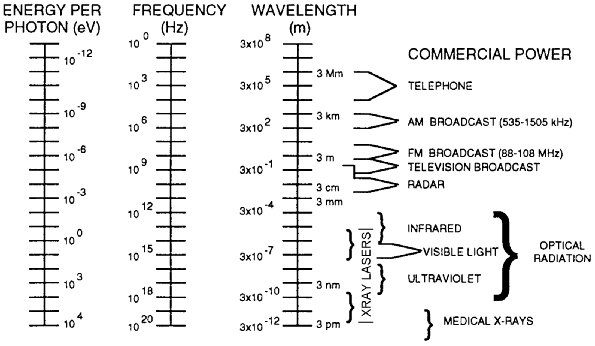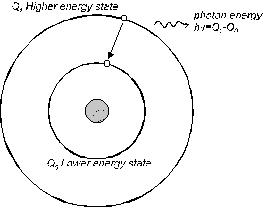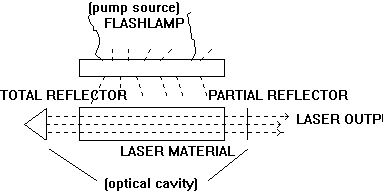
Figure 1. Electromagnetic Spectrum
 [Index]
[Index]
Laser
Fundamentals
Robert Aldrich
TABLE OF CONTENTS
INTRODUCTION
LASER THEORY AND OPERATION
COMPONENTS OF A LASER
TYPES OF LASERS
CHARACTERISTICS OF
MATERIALS
The word "laser" is an acronym for Light Amplification by Stimulated Emission of Radiation. Lasers are finding ever increasing military applications -- principally for target acquisition, fire control, and training. These lasers are termed rangefinders, target designators, and direct-fire simulators. Lasers are also being used in communications, laser radars (LIDAR), landing systems, laser pointers, guidance systems, scanners, metal working, photography, holography, and medicine.
In this document the word laser will be limited to electromagnetic radiation emitting devices using light amplification by stimulated emission of radiation at wavelengths from 180 nanometers to 1 millimeter. The electromagnetic spectrum includes energy ranging from gamma rays to electricity. Figure 1 illustrates the total electromagnetic spectrum and wavelengths of the various regions.

Figure 1. Electromagnetic Spectrum
The primary wavelengths of laser radiation for current military and commercial applications include the ultraviolet, visible, and infrared regions of the spectrum. Ultraviolet radiation for lasers consists of wavelengths between 180 and 400 nm. The visible region consists of radiation with wavelengths between 400 and 700 nm. This is the portion we call visible light. The infrared region of the spectrum consists of radiation with wavelengths between 700 nm and 1 mm. Laser radiation absorbed by the skin penetrates only a few layers. In the eye, visible and near infrared radiation passes through the cornea, and is focused on and absorbed by the retina. It is the wavelength of the light that determines the visible sensation of color: violet at 400 nm, red at 700 nm, and the other colors of the visible spectrum in between. When radiation is absorbed, the effect on the absorbing biological tissue is either photochemical, thermal, or mechanical: in the ultraviolet region, the action is primarily photochemical; in the infrared region, the action is primarily thermal; and in the visible region, both effects are present. When the intensity of the radiation is sufficiently high, damage to the absorbing tissue will result.
A basic understanding of how a laser operates helps in
understanding the hazards when using a laser device. Figure 2
shows that electromagnetic radiation is emitted whenever a
charged particle such as an electron gives up energy. This
happens every time an electron drops from a higher energy state, ![]() ,
to a lower energy state,
,
to a lower energy state, ![]() , in an atom or ion as
occurs in a fluorescent light. This also happens from changes in
the vibrational or rotational state of molecules.
, in an atom or ion as
occurs in a fluorescent light. This also happens from changes in
the vibrational or rotational state of molecules.
The color of light is determined by its frequency or
wavelength. The shorter wavelengths are the ultraviolet and the
longer wavelengths are the infrared. The smallest particle of
light energy is described by quantum mechanics as a photon. The
energy, E, of a photon is determined by its frequency, ![]() ,
and Planck's constant, h.
,
and Planck's constant, h.
|
(1) |
The velocity of light in a vacuum, c, is 300 million meters
per second. The wavelength, ![]() , of light is related to
, of light is related to ![]() from the following equation:
from the following equation:
|
(2) |
The difference in energy levels across which an excited electron drops determines the wavelength of the emitted light.

Figure 2. Emission of radiation from an atom by transition of an
electron from a higher energy state to a lower energy state
As shown in figure 3, the three basic components of a laser are:

Figure 3. Solid State Laser Diagram
Electrons in the atoms of the lasing material normally reside in a steady-state lower energy level. When light energy from the flashlamp is added to the atoms of the lasing material, the majority of the electrons are excited to a higher energy level -- a phenomenon known as population inversion. This is an unstable condition for these electrons. They will stay in this state for a short time and then decay back to their original energy state. This decay occurs in two ways: spontaneous decay -- the electrons simply fall to their ground state while emitting randomly directed photons; and stimulated decay -- the photons from spontaneous decaying electrons strike other excited electrons which causes them to fall to their ground state. This stimulated transition will release energy in the form of photons of light that travel in phase at the same wavelength and in the same direction as the incident photon. If the direction is parallel to the optical axis, the emitted photons travel back and forth in the optical cavity through the lasing material between the totally reflecting mirror and the partially reflecting mirror. The light energy is amplified in this manner until sufficient energy is built up for a burst of laser light to be transmitted through the partially reflecting mirror.
As shown in figure 4, a lasing medium must have at least one excited (metastable) state where electrons can be trapped long enough (microseconds to milliseconds) for a population inversion to occur. Although laser action is possible with only two energy levels, most lasers have four or more levels.

Figure 4. Three level laser energy diagram
A Q-switch in the optical path is a method of providing laser pulses of an extremely short time duration. A rotating prism like the total reflector in figure 3 was an early method of providing Q-switching. Only at the point of rotation when there is a clear optical path will light energy be allowed to pass. A normally opaque electro-optical device (e.g., a pockels cell) is now often used for a Q-switching device. At the time of voltage application, the device becomes transparent, the light built up in the cavity by excited atoms can then reach the mirror so that the cavity Quality, Q, increases to a high level and emits a high peak power laser pulse of a few nanoseconds duration. When the phases of different frequency modes of a laser are synchronized (locked together), these modes will interfere with each other and generate a beat effect. The result is a laser output with regularly spaced pulsations called "mode locking". Mode locked lasers usually produce trains of pulses with a duration of a few picoseconds to nanoseconds resulting in higher peak powers than the same laser operating in the Q-switched mode. Pulsed lasers are often designed to produce repetitive pulses. The pulse repetition frequency, prf, as well as pulse width is extremely important in evaluating biological effects.
The laser diode is a light emitting diode with an optical cavity to amplify the light emitted from the energy band gap that exists in semiconductors as shown in figure 5. They can be tuned by varying the applied current, temperature or magnetic field.

Figure 5. Semiconductor laser diagram
Gas lasers consist of a gas filled tube placed in the laser cavity as shown in figure 6. A voltage (the external pump source) is applied to the tube to excite the atoms in the gas to a population inversion. The light emitted from this type of laser is normally continuous wave (CW). One should note that if brewster angle windows are attached to the gas discharge tube, some laser radiation may be reflected out the side of the laser cavity. Large gas lasers known as gas dynamic lasers use a combustion chamber and supersonic nozzle for population inversion.

Figure 6. Gas laser diagram
Figure 7 shows a dye laser diagram. Dye lasers employ an active material in a liquid suspension. The dye cell contains the lasing medium. Many dyes or liquid suspensions are toxic.

Figure 7. Common Dye Laser Diagram
Free electron lasers such as in figure 8 have the ability to generate wavelengths from the microwave to the X-ray region. They operate by having an electron beam in an optical cavity pass through a wiggler magnetic field. The change in direction exerted by the magnetic field on the electrons causes them to emit photons.

Figure 8. Free Electron Laser Diagram
Laser beam geometries display transverse electromagnetic (TEM) wave patterns across the beam similar to microwaves in a wave guide. Figure 9 shows some common TEM modes in a cross section of a laser beam.

Figure 9 Common TEM laser beam modes
A laser operating in the ![]() mode could be considered
as two lasers operating side by side. The ideal mode for most
laser applications is the
mode could be considered
as two lasers operating side by side. The ideal mode for most
laser applications is the ![]() mode and this mode is
normally assumed to easily perform laser hazards analysis. Light
from a conventional light source is extremely broadband
(containing wavelengths across the electromagnetic spectrum). If
one were to place a filter that would allow only a very narrow
band of wavelengths in front of a white or broadband light
source, only a single light color would be seen exiting the
filter. Light from the laser is similar to the light seen from
the filter. However, instead of a narrow band of wavelengths none
of which is dominant as in the case of the filter, there is a
much narrower linewidth about a dominant center frequency emitted
from the laser. The color or wavelength of light being emitted
depends on the type of lasing material being used. For example,
if a Neodymium:Yttrium Aluminum Garnet (Nd:YAG) crystal is used
as the lasing material, light with a wavelength of 1064 nm will
be emitted. Table 1 illustrates various types of material
currently used for lasing and the wavelengths that are emitted by
that type of laser. Note that certain materials and gases are
capable of emitting more than one wavelength. The wavelength of
the light emitted in this case is dependent on the optical
configuration of the laser.
mode and this mode is
normally assumed to easily perform laser hazards analysis. Light
from a conventional light source is extremely broadband
(containing wavelengths across the electromagnetic spectrum). If
one were to place a filter that would allow only a very narrow
band of wavelengths in front of a white or broadband light
source, only a single light color would be seen exiting the
filter. Light from the laser is similar to the light seen from
the filter. However, instead of a narrow band of wavelengths none
of which is dominant as in the case of the filter, there is a
much narrower linewidth about a dominant center frequency emitted
from the laser. The color or wavelength of light being emitted
depends on the type of lasing material being used. For example,
if a Neodymium:Yttrium Aluminum Garnet (Nd:YAG) crystal is used
as the lasing material, light with a wavelength of 1064 nm will
be emitted. Table 1 illustrates various types of material
currently used for lasing and the wavelengths that are emitted by
that type of laser. Note that certain materials and gases are
capable of emitting more than one wavelength. The wavelength of
the light emitted in this case is dependent on the optical
configuration of the laser.
Table 1. Common Lasers and Their Wavelengths
LASER TYPE |
WAVELENGTH (Nanometers) |
Argon Fluoride |
193 |
Xenon Chloride |
308 and 459 |
Xenon Fluoride |
353 and 459 |
Helium Cadmium |
325 - 442 |
Rhodamine 6G |
450 - 650 |
Copper Vapor |
511 and 578 |
Argon |
457 - 528 (514.5 and 488 most used) |
Frequency doubled Nd:YAG |
532 |
Helium Neon |
543, 594, 612, and 632.8 |
Krypton |
337.5 - 799.3 (647.1 - 676.4 most used) |
Ruby |
694.3 |
Laser Diodes |
630 - 950 |
Ti:Sapphire |
690 - 960 |
Alexandrite |
720 - 780 |
Nd:YAG |
1064 |
Hydgrogen Fluoride |
2600 - 3000 |
Erbium:Glass |
1540 |
Carbon Monoxide |
5000 - 6000 |
Carbon Dioxide |
10600 |
Light from a conventional light source diverges or spreads rapidly as illustrated in figure 10. The intensity may be large at the source, but it decreases rapidly as an observer moves away from the source.

Figure 10. Divergence of Conventional Light Source
In contrast, the output of a laser as shown in figure 11 has a very small divergence and can maintain high beam intensities over long ranges. Thus, relatively low power lasers are able to project more energy at a single wavelength within a narrow beam than can be obtained from much more powerful conventional light sources.

Figure 11. Divergence of Laser Source
For example, a laser capable of delivering a 100 mJ pulse in
20 ns has a peak power of 5 million watts. A CW laser will
usually have the light energy expressed in watts, and a pulsed
laser will usually have its output expressed in joules. Since
energy cannot be created or destroyed, the amount of energy
available in a vacuum at the output of the laser will be the same
amount of energy contained within the beam at some point
downrange (with some loss in the atmosphere). Figure 12
illustrates a typical laser beam. The amount of energy available
within the sampling area will be considerably less than the
amount of energy available within the beam. For example, a 100 mW
laser output might have 40 mW measured within 1 ![]() sample area. The irradiance in this example is 40 mW/
sample area. The irradiance in this example is 40 mW/![]() .
.

Figure 12. Illustration of Irradiance
Materials can reflect, absorb, and/or transmit light rays. Reflection of light is best illustrated by a mirror. If light rays strike a mirror, almost all of the energy incident on the mirror will be reflected. Figure 13 illustrates how a plastic or glass surface will act on an incident light ray. The sum of energy transmitted, absorbed, and reflected will equal the amount of energy incident upon the surface.
A surface is specular (mirror-like) if the size of surface imperfections and variations are much smaller than the wavelength of incident optical radiation. When irregularities are randomly oriented and are much larger than the wavelength, then the surface is considered diffuse. In the intermediate region, it is sometimes necessary to regard the diffuse and specular components separately.

Figure 13. Light Ray Incident to Glass Surface
A flat specular surface will not change the divergence of the incident light beam significantly. However, curved specular surfaces may change the divergence. The amount that the divergence is changed is dependent on the curvature of the surface. Figure 14 demonstrates these two types of surfaces and how they will reflect an incident laser beam. The divergence and the curvature of the reflector have been exaggerated to better illustrate the effects. Note that the value of irradiance measured at a specific range from the reflector will be less after reflection from the curved surface than when reflected from the flat surface unless the curved reflector focuses the beam near or at that range.
A diffuse surface is a surface that will reflect the incident
laser beam in all directions. The beam path is not maintained
when the laser beam strikes a diffuse reflector. Whether a
surface is a diffuse reflector or a specular reflector will
depend upon the wavelength of the incident laser beam. A surface
that would be a diffuse reflector for a visible laser beam might
be a specular reflector for an infrared laser beam (e.g., ![]() ). As illustrated in Figure 15, the effect of various curvatures
of diffuse reflectors makes little difference on the reflected
beam.
). As illustrated in Figure 15, the effect of various curvatures
of diffuse reflectors makes little difference on the reflected
beam.
If light is incident upon an interface separating two transmitting media (as an air-glass interface), some light will be transmitted while some will be reflected from the surface. If no energy is absorbed at the interface, T + R = 1 where T and R are the fractions of the incident beam intensity that are transmitted and reflected. T and R are called the transmission and reflection coefficients, respectively. These coefficients depend not only upon the properties of the material and the wavelength of the radiation, but also upon the angle of incidence. The amount of the incident light beam that is reflected and the amount transmitted through the material is further dependent on the polarization of the light beam.
The angle that an incident ray of radiation forms with the
normal to the surface will determine the angle of refraction and
the angle of reflection (the angle of reflection equals the angle
of incidence). The relationship between the angle of incidence (![]() ) and the angle of refraction (
) and the angle of refraction (![]() ') is
') is
|
(3) |
where n and n' are the indices of refraction of the media that the incident and transmitted rays move through, respectively (see figure 13).

Figure 14. Specular Reflectors

Figure 15. Diffuse Reflectors